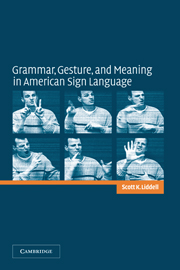Book contents
- Frontmatter
- Contents
- Preface
- Acknowledgments
- 1 American Sign Language as a language
- 2 A sketch of the grammar of ASL
- 3 Pronouns and real space
- 4 Indicating verbs and real space
- 5 Surrogates
- 6 Directing signs at locations and things
- 7 Tokens
- 8 Buoys
- 9 Depicting verbs
- 10 Five brothers
- 11 Grammar, gesture, and meaning
- Appendixes
- References
- General index
- Index of illustrated signs
Preface
Published online by Cambridge University Press: 05 June 2012
- Frontmatter
- Contents
- Preface
- Acknowledgments
- 1 American Sign Language as a language
- 2 A sketch of the grammar of ASL
- 3 Pronouns and real space
- 4 Indicating verbs and real space
- 5 Surrogates
- 6 Directing signs at locations and things
- 7 Tokens
- 8 Buoys
- 9 Depicting verbs
- 10 Five brothers
- 11 Grammar, gesture, and meaning
- Appendixes
- References
- General index
- Index of illustrated signs
Summary
The recognition that sign languages are real human languages was a watershed event with potentially profound effects, not only in the daily lives of Deaf people, but on an entire set of disciplines related to language and cognition. When William Stokoe (1960) made the original arguments proposing that American Sign Language (ASL) was a real human language, he based his arguments on finding parallels between the abstract grammatical structures of ASL and the types of abstract grammatical structures found in spoken languages. In the four decades since that discovery, sign languages have been analyzed in countries throughout the world. The analyses of ASL and other sign languages demonstrate that sign languages are an incredibly fertile field for research, with potentially far-reaching implications.
There is, however, one major difference between sign languages and vocally produced languages. ASL and all other sign languages I am aware of include significant numbers of signs that can be meaningfully placed or directed in space. One instance of such a directional sign may differ from the next instance of ‘the same’ sign depending on how the sign is directed or placed in the space ahead of the signer. For example, the verb TELL begins with the index finger in contact with the chin. If the finger moves outward toward the addressee, the verb expresses the meaning ‘tell you’. If it moves outward toward a female (non-addressee) present in the room, it expresses the meaning ‘tell her’. No one disputes the meaningfulness of this type of directionality.
- Type
- Chapter
- Information
- Grammar, Gesture, and Meaning in American Sign Language , pp. viii - xiiPublisher: Cambridge University PressPrint publication year: 2003



